As an adolescent, I always enjoyed watching how my late grandfather worked in his small woodworking shop. I can never forget the cutting board he made using epoxy resin, which was still quite a novelty at that time. When I built my own cutting board as my first woodworking project, I didn’t know anything about food-grade wood finishes. So I started researching.
I read everything I could on the internet, and I have decided to share my findings with you. In this article, you will learn what you have to consider before applying a finish on wood projects that will be in contact with food.
In short, here’s a list of the best food-safe wood finishes that you can use on cutting boards, bowls, and kitchen utensils:
| 1. Mineral Oil | 5. Pure Tung Oil |
| 2. Beeswax | 6. Linseed Oil |
| 3. Walnut Oil | 7. Fractionated Coconut Oil |
| 4. Carnauba Wax | 8. Shellac |
Read on to find out why.
Best Finishes That Are Food-Safe
There is a surprising variety of wood finishes that are available to us today. I started with the products that my grandfather used while supplementing them with others that I wanted to try out. The following finishes are worth considering, especially on your wood projects that need to be food-safe.
1. Mineral oil
These oils are often made from distilled petroleum or other mineral sources. It is clear in nature, a feature that highlights the wood’s natural look. It is effective at filling smaller pores and imperfections on the wood’s surface. That may be an important consideration for woodworkers who desire a natural look for their cooking ware.
Mineral oil does not smell and will not add an odor to the food items that it comes into contact with. They work well as an overcoat on wood stains that are water-based but should be avoided if your stain is oil-based.

- FOOD SAFE MINERAL OIL FOR CUTTING BOARD: Our Cutting Board White Mineral Oil is a smooth, lightweight oil that is ideal as a conditioner and protectant for treating wooden and bamboo cooking products,...
- CUTTING BOARD OIL TO BRING LIFE BACK TO YOUR CUTTING BOARD: This smooth USP & Food Grade Mineral Oil is ideal for protecting cooking products made of wood from cracking or splitting. It can also be...
- BUTCHER BLOCK OIL: Mineral oil can be used a butcher block conditioner and can be used as a wood oil. Our mineral oil is unscented, colorless, odorless, tasteless, and gluten free.
You should find mineral oils for a cheaper price point when compared to many types of finishes. This product provides a soft finish that will work well on cutting boards or wooden countertops. It lacks a bit in the durability department, however, and will require regular maintenance that will include re-coating your projects.
If you are considering mineral oil as a finish, it is important to understand that these products are available in crude or refined products. Crude mineral oil is often used in industrial settings and should be avoided if possible. Instead, look for refined mineral oil, as the FDA lists them as safe to use in cosmetics and food.
2. Beeswax
This product has been used for centuries as a finish and polish for wood. It is natural and lacks harsh chemicals that are less desirable. Many woodworkers prefer this material made by honey bees due to this benefit.
One thing to keep in mind is that beeswax will require a bit more work to use when compared to some finishes. You will need to melt it so that it becomes soft enough to work with. Beeswax will harden quickly, so many joiners mix it with an oil (tung oil is often used) to extend its working time.

- Preserving Your Cutting Boards: After applying CLARK' S oil, fortify your beeswax cutting board and butcher blocks with our wood wax. This beeswax butcher block conditioner adds a protective barrier,...
- Premium Natural Ingredients: CLARK' S cutting board wood wax is a harmonious blend of beeswax, carnauba wax, and food-grade oils. This beeswax finish for your butcher block countertop offers a tougher...
- Simple and Effective Application: Using CLARK’S beeswax countertop wax is a breeze. Simply apply the wood wax paste, let it harden for 2-3 hours, then buff off any excess. This creates a durable...
Another trick that users do when applying this material is to add lemon essential oil to provide a pleasant scent. Some people claim that lemon oil also acts as an antibacterial agent that will benefit food-related wooden items.
Beeswax provides a decent level of protection on wood surfaces, but it will not penetrate as deeply into the wood as other products can. It will require regular re-applications often in order to provide the best protection. This natural product is non-toxic and should be safe for most people to use.
When it is applied and buffed, the wood will take on a warm look that highlights its natural colors. It also creates a surface that feels silky smooth when you touch it, a quality that differentiates it from hard and smooth varnishes.
3. Walnut Oil
European readers may be familiar with this finish that is often used by French woodworkers. It can be applied on decoration pieces by mixing it with mineral oil, but it should be used pure when applying it on food-safe items.
Food utensils will see a lot of use, so they will require at least six coats of walnut oil for optimal protection. It provides great protection from liquids, including alcohol and water. Keep in mind that this product can have adverse effects on people who suffer from food allergies.

- PRESERVE THE BEAUTY OF UNFINISHED WOOD - This premium walnut oil helps maintain natural wood beauty and integrity. If your wooden bowl, block, or cutting board looks dry, make sure to apply Andrew...
- NON-TOXIC, FOOD SAFE & ALLERGEN FREE - Apply our high grade walnut oil to wood kitchen utensils and items and more without the worry.
- HOW TO USE - If it feels and/or looks dry, then liberally wipe on Andrew Pearce Wood Oil with a soft white cloth. The more you use your wood, the more often you will want to recondition it.
It will penetrate wood grain nicely and should help to highlight multi-colored wood. Walnut oil will require that you do touch-ups on your utensils, but the level of maintenance should be less than with a product like beeswax.
4. Carnauba Wax
Carnauba wax is derived from the Brazilian palm tree. It is considered food-safe as it is a natural vegetable-based wax product. This wax is often mixed with beeswax as it can be difficult to achieve a consistent look when used pure.
This wax will require two to three coats to provide the best coverage possible. It will not penetrate wood grain, a characteristic common with all wax products. This material will provide a bit more durability than beeswax will in many cases, but it will wear over time and needs to be re-applied.
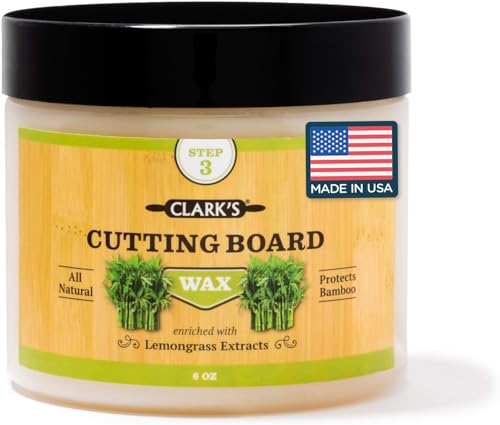
- PROTECTIVE SEAL: Enhance the longevity of your Bamboo Cutting Boards, Utensils, or Countertops by applying our food grade mineral oil, followed by CLARK’S Bamboo wood wax. This creates a protective...
- NATURAL FORMULA: Our mix of food-safe beeswax, carnauba wax, lemongrass extract, and mineral oil is specially formulated for bamboo wax applications. It boasts more carnauba wax than other brands,...
- EASY APPLICATION: Apply the beeswax cutting board wax with ease - simply rub it on your bamboo wood surface, let it sit and harden for a couple of hours, then buff off any excess wax. For optimal...
It offers a soft feel when touched and generates a satin-like shine. Many woodworkers will apply another protective product over carnauba wax but it can offer you a coating that is non-toxic.
5. Pure Tung Oil
A popular selection for many joiners is this product made from nuts of the tung tree. Part of this popularity is due to the durability of this finish, a trait that offers hardiness as well as lower maintenance. It also supplies wood items with decent water resistance, something that is required for food-related wood items. Is tung oil safe for food, though?
Tung oil makes my list here as it is food-safe after three days of curing and repels food particles that can stick in the pores on wood surfaces. This protection will need monthly re-application to offer a high level of protection.
No products found.
When looking at tung oil products, make sure that they are pure. Oil and varnish blends, as well as wipe-on products, contain solvents that most woodworkers want to avoid when using on food-related items.
6. Linseed Oil
This product is one of the oldest finishes used on wooden items by ancient Egyptians. Linseed is often used by Europeans but has been supplanted by flaxseed and other products in North America. It has gained in popularity, especially with beginners, as it is easy to apply.
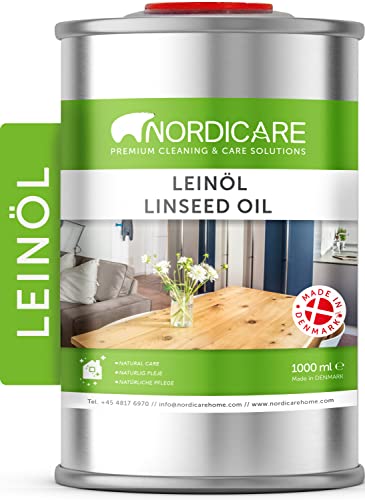
- 🌱 OUR PURE LINSEED OIL FOR WOOD: is a vegetable oil for treatment and maintenance of all solid wood. The oil leaves a 100% biological surface and underlines the original natural structure of the...
- 🌱 IDEAL FOR YOUR INDOOR AREA - The Nordicare Furniture Linseed Oil is characterised by its universal use - as it consists of 100% cold-pressed linseed oil, it can be used safely in the entire...
- 🌱 EASY TO APPLY: Apply generously with a cloth or brush and wipe off excess oil after 1 hour. New or dried up wood requires repeated treatment; however, the oil must be left to harden at least 24...
It will take longer to cure than many other finishes, but that cured surface provides a lower luster that many woodworkers prefer for their food-related utensils. It should be noted that linseed oil does not provide the best protection against water. Scratching can also be an issue unless you cover your project with several layers.
7. Fractionated Coconut Oil
Fractionated coconut oil has been refined to the point of removing LCT (long-chain triglycerides), a process that prevents this product from going rancid. It offers users a food-safe finish that is non-toxic and has become more popular among hobbyists in recent years.

- FDA Food-Safe Ingredients
- Plant-Based / Vegan
- Great for Cutting Boards and Wooden Spoons
It can be applied in the same manner as other vegetable-based products and will offer a softer finish for your projects. This helps to prevent chipping on items like cutting boards and other surfaces that receive abuse. It is also considered an economical alternative by some woodworkers.
8. Shellac
The last product on this list was actually the first finish I was introduced to by my grandfather. French polishing has remained a popular method of application with traditional woodworkers, and I can recommend trying it out if you have not worked with it before.
While pre-made shellacs are available, I would recommend mixing your own. This avoids waxes or other materials causing adhesion issues. Homemade shellac will also store longer than most pre-made products.
It will require a lot of work to cover the wood evenly, but it can be built up in layers to achieve the desired look you want with your project. It is used in candy and pharmaceutical products, so you will not have to worry about it being food-safe.
Use These Finishes With Caution
Polyurethane
Today’s polyurethane finishes are not the same as the ones your grandparents used years ago. Metallic driers are used in these products to help reduce the drying time that will be required for a full cure. Lead was once used as a drier but has been banned for several years now.
I have found no research that indicates that the driers used today pose a health risk when applied to wooden utensils and cookware. It is important to keep in mind that all products, especially finishes like polyurethane, are allowed to cure completely before use. That may require up to 30 days, but it should provide a food-safe coating when curing is complete.
Lacquer
Lacquers are similar to polyurethanes in regard to curing time. As a matter of fact, they will usually need longer to dry than almost any other finish you will use. This type of finish should be food-safe once it has fully matured throughout the entire coating.
Another consideration is that lacquers do not penetrate the wood grain but sit on top of the wood surface instead. That makes it an adequate finish for items that will not be roughed up, like serving trays, for example. They will tend to shed chips on cutting board surfaces, so alternative finishes may be desired in those applications.
Vegetable oils
A few vegetable-based oils were listed previously that can be used as a wood finish. Most vegetable oils should be used with caution or avoided if possible. There are several reasons I suggest this.
Most of these products will thicken on utensil surfaces over time and can become cloudy in appearance as well as generating an off feel to the wood surface. Applying vegetable oils will also discolor your wooden projects in many instances, leaving them with a look you did not intend for them to have. Finally, they can become rancid and will make your food-safe wooden utensils smell bad.
Important wood finish considerations
Keep in mind that many finishes will become safe to use on dishes if they are properly applied and have enough time to cure completely. There are some things that you will want to pay special attention to when applying them to wooden dishes, however.
Avoid oils that can spoil
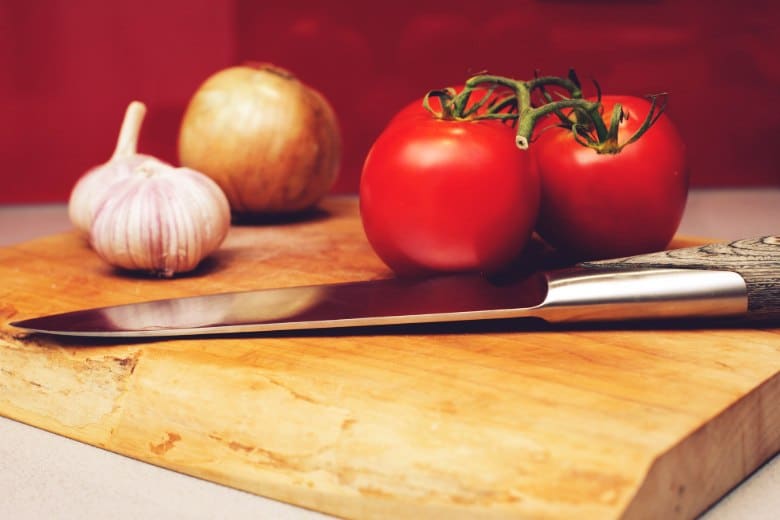
There are people who have suggested that you use vegetable oil or olive oil as a coating on wooden utensils. My recommendation: Don’t! These types of oils are made from fats extracted from vegetables.
As you might expect, these oils have a shelf life and will spoil over time. I have not heard of short-term illnesses caused by consuming rancid oils, but they do contain free radicals that may increase your chances of developing certain types of cancers. These oils will not remain on the surface and can cause an off-taste when the utensils are used.
Keep in mind curing time
Is your finish ready once it has dried? No, it is not. There is a difference between drying time and curing time.
Wood finishes that are pre-made will often list a drying time on their label. This is the amount of time the manufacturer suggests you wait before applying additional coats. The surface layer will feel dry to the touch with most products, but the material under that dry surface will not have dried.
Pre-made products will also list a curing time for each product. This indicates the amount of time you need to wait before using the finished item. It will be dry from the surface to the deepest spots of penetration.
Levels of toxicity
The first area of concern when it comes to toxicity is during application on your projects. You should always have good ventilation in your shop, and I would recommend that you also purchase breathing protection.
Most woodworkers think of dust masks when contemplating protection. These may work great for keeping wood particles out of your nose and lungs, but they will not protect you from chemical vapors. You need to get a respirator that is designed to pull harmful chemicals out of the air that you breathe in through the respirator.
Another concern for many is the toxicity levels of treated wood items used for food and toys. Boiled linseed oil and tung oils are the least toxic finishes you can use. Shellacs and water-based finishes are the next best options in this regard. Finally, finishes like lacquers represent the most toxic finishes you will use.
Most finishes, no matter what type they are, will be usable on wooden dishes if you apply them as the manufacturer suggests, as well as make sure they are completely cured before use. Each product is different, even if they are made by the same company. Most companies will list products that meet government standards for food safety.
How will heat affect the finish?
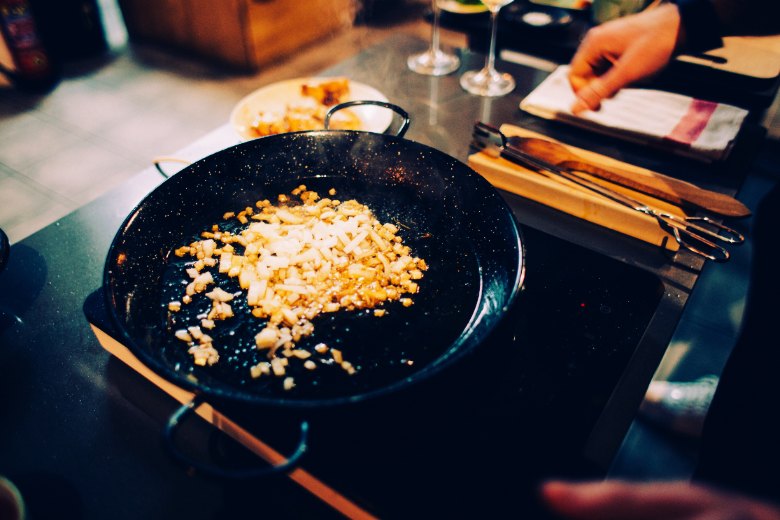
Again, there will be two scenarios to keep in mind here. The first concern is the temperature range at which the product should be stored and used. Chemicals can break down if they are stored at too low of a temperature or may combust if kept at a temperature beyond the recommended range. Also, you will want to follow the manufacturer’s recommendation for the best application temperature range for the best results.
Secondly, you will want to consider the temperature at which the utensils will be used. Items used for cooking (like spoons or spatulas) will be used on hot cooking surfaces. Verify on the label if the finish will tolerate these extremes without breaking down or melting as you cook.
Will the finish hold up?
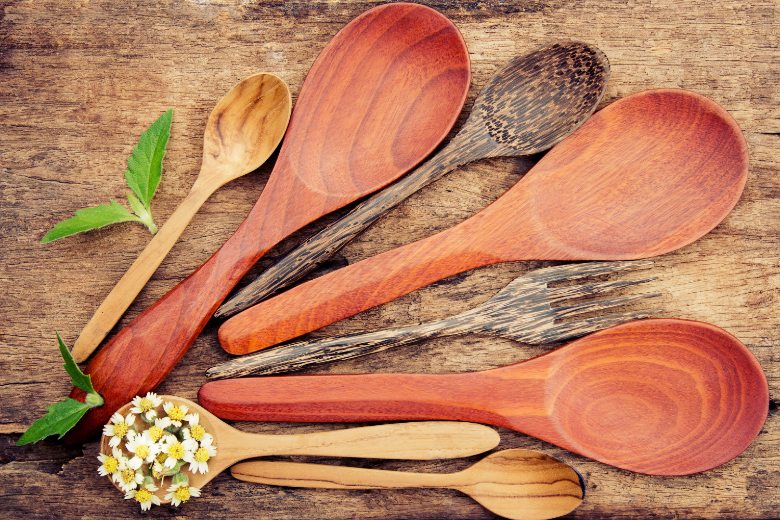
In many cases, you will want to apply a finish that produces a hard surface. There are times that you may want to avoid this, such as finishing a cutting board. If the wooden item is cut or hammered on, you might want a softer finish that gives a bit to avoid flaking that can cling to your food.
The durability of a particular finish should also be considered with the shape of the item. Boards or utensils with sharp edges will likely wear out sooner than they would with a beveled or rounded edge.
Grooves and indentations can also be problematic, becoming a collection point for bacteria or grease build-up. Softer finishes may become more susceptible than harder coatings as they will be more porous. Unwanted build-up can penetrate the surface, making it impossible to clean off and forcing you to strip down the finish and re-applying it.
Finishing It Off
As you can see, there are many food-safe wood finish options out there. Give more than one of them a try to see which you prefer working with. Keep your woodworking safe and healthy!

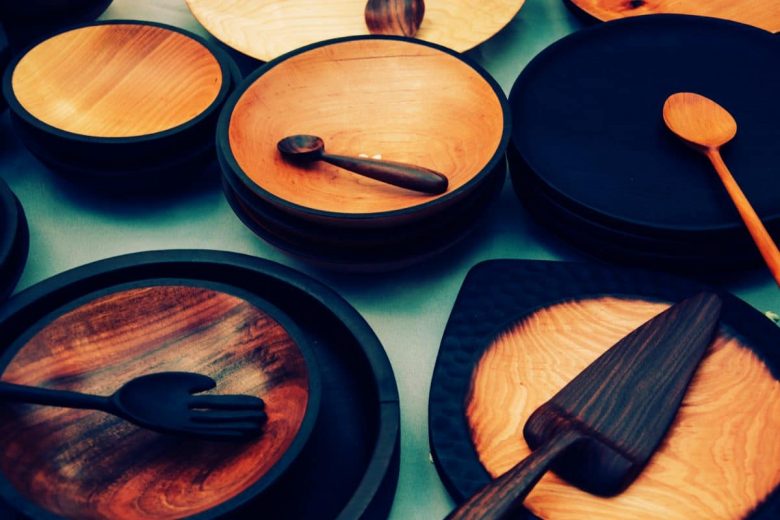
19 thoughts on “What Are The Best Food-Safe Wood Finishes?”
Hi! So if I have a container of walnut oil which I purchased for cooking purposes, can I use this on the wooden handles of a Danish whisk or on my cherry wooden spoons?
Hi Janet,
Thanks for your question.
Is this oil refined? If it is then feel free to use it on your wooden spoons.
I bought some wooden plant boxes with the intent of growing some herbs, but I don’t know what the wood was treated with prior (if at all – but it does seem to have been lightly stained). I was considering sanding it down a bit, potentially painting it (only on the outside) and then coating it with a sealant so that nothing in the wood or the sealant itself is absorbed into the plants roots.
However, I also see that the differences between sealants, their longevity, and durability make it a more difficult choice than I thought. Is there a particular sealant that would cause the least problems / longest durability while being safe to grow food in? Sorry if this is a tricky question!
Hi JC,
That’s a great question.
Any of the wood finishes I listed out as food-safe in this guide should be good to use inside your planter boxes. Personally, I’d go with raw linseed oil or tung oil.
Hope this helps.
hi
I have read book for oil finish. The book says ” DO not use boiled linseed oil as a finish for surfaces that may come into contact with food”
I’m confusing.
Can I use linseed oil for the food contact items?
The book is learning material that is the result of a collaborative effort between the
NAIT, SAIT and the following Alberta apprenticeship training providers.
Hey there,
Thank you for sharing your thoughts.
Do not use boiled linseed oil as it usually has chemical driers added to it which makes it unsuitable for items that come in contact with food.
Look for raw linseed oil. Sometimes it is called Flaxseed oil.
We are thinking of making torched wood countertops. Would like to put a thick layer of protection on them after staining. Was told we needed a food safe coating and wanted to know the best and most durable. Durable as in existing chips & scrapes and if possible slightly heat damage resistant.
Hi Dana,
All of the finishes discussed in this list will be ok just make sure you give it enough time to cure.
You might also consider a clear epoxy finish for a countertop. Once cured, they will provide an extremely durable surface.
How long do they need to cure?
Hi Vanessa,
Thank you for your question.
Oil-based finishes take around 4 weeks to fully cure.
I recently purchased an unfinished butcher block counter top and would like to stain it to a darker color like walnut and then use one of the above mentioned finishes. Knowing food will come in contact with the surface, will the finish protect food from the underlaid stain? Is there a food safe stain? Thanks
Hi John,
Thanks for your question. Sure, the finish will stay on top of the stain. Just make sure you give the finish enough time to cure.
I am making honey pots for some friends. Would a beeswax/mineral oil combination finish work for this? They will be washed at sometime so I’m thinking they would need to reapply after washing?
Hi Randy,
Thanks for your question.
Sure, that will work but the layer of beeswax will need to be reapplied regularly. Hope this helps.
I have a 4-5 year-old bamboo wood cutting board. That needs some care. I am thinking of lightly sanding it using >400 grit and then applying mineral oil. What do you think? Any better idea that is superior to this?
Hi Mukesh,
Mineral oil will work just fine. Sand with 800 grit sandpaper for best results.
Best regards,
Arthur
I made a baseball bat beer mug and need to seal the inside. Marketers of these mug claim they use a water based food safe product to seal their mug. I have contacted several manufacturers. None of them recommend a product for this use. Food safe epoxy also has no recommendation for this application. It’s hard to accept that a small business marketing a mug has a food safe sealant that no manufacturer is aware exists. Any ideas?
Hey Richard,
Thanks for stopping by.
Generally, any of the products from this list should work fine for your mug. I’d go with tung oil as I love the look of it, but that is a personal preference. Mineral oil will also work just fine. It won’t affect the look of the wood as much but will require more regular re-application.
Hope this helps.